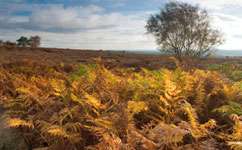Native thugs as bad for woodlands as foreign invaders

Some of Britain's most recognisable plants – like brambles, bracken and ivy – can damage British woodlands just as much as marauding invasive plants, according to new research.
Scientists found that in some places, so-called 'thug' plants could even be worse for woodlands than some alien plants like rhododendron, sycamore and Himalayan balsam.
"The problem is these native plants grow incredibly quickly, so take up lots of space, and soon drive out other slower-growing plants. The end result is a woodland with fewer native plants than before, and so less diversity," says Professor Rob Marrs from the University of Liverpool, lead author of the study, published in Kew Bulletin.
Invasive species are a major problem across the world. Indeed, back in 2005, the Millennium Ecosystem Assessment recognised them as a major threat to the conservation of the diversity of life on Earth.
Although beautiful, some rhododendron plants grow so voraciously that they push other species out, not just in woodlands, but in parks and gardens. They can also produce chemicals which stop all other species from growing in the same soil. Similarly, once the native bracken takes hold, it won't loosen its grip without a battle.
Once they've got into a country, many invasive species are hard to control or eradicate. But researchers and conservationists have focussed much of their energy on doing just that – a huge and expensive challenge.
Now Marrs and his co-authors say conservationists should also take these 'thug' plants into account in their woodland management policies.
"From a conservation point of view, these plants are potentially more damaging to native woodlands than alien invaders," Marrs says.
"Lots of money is spent on eradicating alien plants, but there's certainly a case for controlling native species as well," he adds.
Earlier research had highlighted 'thug' species as a potential problem for British woodland diversity. But until now, no-one had compared their effect on woodlands with the effect of invasive species.
So Marrs and his colleagues decided to investigate. They compared the coverage of native 'thug' plants like stinging nettles, bracken, ivy and brambles in 103 woodlands with the abundance of sycamore, Himalayan balsam and rhododendron in woodlands across the country. Most (60 per cent) of the woodlands they studied are classed as ancient woodland.
At the end of their three-year study, they found the most common species on the woodland floor included three of these 'thug' plants: bramble, bracken and ivy. They also found that these species were four times more widespread than invasive sycamore, Himalayan balsam and rhododendron in the woodlands they studied.
"Our research puts the effect of alien species into perspective," Marrs says.
While these fast-growing native plants significantly cut the diversity of other woodland plants, the researchers found that climate, soil type, and how woodlands are managed influences diversity much more.
"It does of course not imply that alien species do not cause problems at the local scale in individual woods, rather that the impact of native 'thug' species might be an even greater risk threat," write the authors in their report.
"We hope our study will prompt ecologists and conservationists to develop woodland management policies based on sound science," says Marrs.
More information: R. H. Marrs, et al., Aliens or natives: who are the 'thugs' in British woods?, Kew Bulletin, Thursday, February 03, 2011, doi:10.1007/s12225-010-9237-9
Source: PlanetEarth Online















